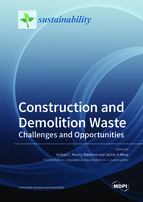Construction and Demolition Waste: Challenges and Opportunities
A special issue of Sustainability (ISSN 2071-1050). This special issue belongs to the section "Sustainable Materials".
Deadline for manuscript submissions: closed (15 December 2021) | Viewed by 47492
Special Issue Editors
Interests: green walls and roofs; photocatalytic materials; nanomaterials; recycling in concrete
Special Issues, Collections and Topics in MDPI journals
Interests: life-cycle assessment, design for sustainability, environmental performance of products and systems, product durability, material selection, valorization of waste from industrial processes and design of circular products (Circular Economy perspective)
Special Issue Information
Dear Colleagues,
Due to the enormous construction material demands for the rising number of buildings and urban infrastructure, the use of construction and demolition waste (C&DW) in building materials becomes a crucial issue for the sustainable development of our planet, especially in developing countries. The extraction of natural aggregates and minerals from mountains and rivers has destroyed vital ecosystems worldwide. Moreover, the manufacture of building materials releases a significant amount of greenhouse emissions. For example, only for producing a ton of Portland cement, a ton of CO2 is approximately released to the atmosphere. Based on this, the construction industry is currently an important producer of global warming gases. Although many efforts have been done made by governments, industries, and scientists to increase the use of C&DW in construction materials, articulated efforts are required at global, regional, and local scales. Therefore, this Special Issue aims to provide a better comparison and assessment of the application potentials of construction and demolition waste in building materials. In particular, the topics of interest include, but are not limited to, the following aspects:
(a) Physical, chemical, mechanical, and durability properties of C&DW aggregates, fillers, and cementitious materials;
(b) Classification and processing techniques for C&DW;
(c) Design of concrete and mortar mixes using C&DW;
(d) Life cycle assessment of construction materials using C&DW;
(e) Novel applications of C&DW.
References:
[1] Naranjo, A.; Colonia, A.; Mesa, J.; Maury-Ramírez, A. Evaluation of Semi-Intensive Green Roofs with Drainage Layers Made Out of Recycled and Reused Materials. Coatings 2020; 10-6: 525. Relation – use of recycled rubber and reused plastic bottles
[2] Etxeberria, M., Guo, MZ., Maury-Ramirez, A., Poon. CS. Influence of dust and oil accumulation on effectiveness of photocatalytic concrete surfaces. Journal of Environmental Engineering – ASCE; 2017; 1-10. Relation – Use of recycled glass as aggregate and filler
[3] Guo, MZ., Maury-Ramirez, A., Poon, CS. Self-cleaning ability of titanium dioxide clear paint coated architectural mortar and its potential in field application. Journal of Cleaner Production 2016; 112: 3583-3588. Relation – Use of recycled glass as aggregate and filler
[4] Guo, MZ., Maury-Ramirez A., Poon, CS. Versatile photocatalytic functions of self-compacting architectural glass mortars and their inter-relationship. Materials & Design 2015; 88: 1260–1268. Relation – Use of recycled glass as aggregate and filler
[5] Guo, MZ., Maury-Ramirez A., Poon, CS. Photocatalytic activities of titanium dioxide incorporated architectural mortars: Effects of weathering and activation light. Building and Environment 2015; 94: 395-402. Relation – Use of recycled glass as aggregate and filler
[6] Mesa J.A., Esparragoza I., Maury H. (2018) “Relative Assessment of Indicators in Sustainability Enhancement (RAISE): a first approach in the manufacturing stage of products”. International Journal of Sustainable Engineering. Published online. https://doi.org/10.1080/19397038.2018.1491070
[7] Mesa J.A., Esparragoza I., Maury H. (2019) “Modular architecture principles – MAPs: a key factor in the development of sustainable open architecture products”. International Journal of Sustainable Engineering. Vol 13, issue 2. https://doi.org/10.1080/19397038.2019.1634157
[8] Mesa, J.A., Esparragoza, I. & Maury, H. (2019) Trends and Perspectives of Sustainable Product Design for Open Architecture Products: Facing the Circular Economy Model. International Journal of Precision Engineering and Manufacturing - Green Technology. Vol 6, 377-391. https://doi.org/10.1007/s40684-019-00052-1
[9] Butera, S., Christensen, TH, Astrup, TF. (2015). Life cycle assessment of construction and demolition waste management, Waste Management, Volume 44, 2015, Pages 196-205, ISSN 0956- 053X. https://doi.org/10.1016/j.wasman.2015.07.011
[10] Di Maria, A., Eyckmans, J., Van Acker, K. (2018). Downcycling versus recycling of construction and demolition waste: Combining LCA and LCC to support sustainable policy making, Waste Management, Volume 75, Pages 3-21, ISSN 0956-053X. https://doi.org/10.1016/j.wasman.2018.01.028
Prof. Dr. Anibal C. Maury-Ramirez
Dr. Jaime A Mesa
Guest Editors
Manuscript Submission Information
Manuscripts should be submitted online at www.mdpi.com by registering and logging in to this website. Once you are registered, click here to go to the submission form. Manuscripts can be submitted until the deadline. All submissions that pass pre-check are peer-reviewed. Accepted papers will be published continuously in the journal (as soon as accepted) and will be listed together on the special issue website. Research articles, review articles as well as short communications are invited. For planned papers, a title and short abstract (about 100 words) can be sent to the Editorial Office for announcement on this website.
Submitted manuscripts should not have been published previously, nor be under consideration for publication elsewhere (except conference proceedings papers). All manuscripts are thoroughly refereed through a single-blind peer-review process. A guide for authors and other relevant information for submission of manuscripts is available on the Instructions for Authors page. Sustainability is an international peer-reviewed open access semimonthly journal published by MDPI.
Please visit the Instructions for Authors page before submitting a manuscript. The Article Processing Charge (APC) for publication in this open access journal is 2400 CHF (Swiss Francs). Submitted papers should be well formatted and use good English. Authors may use MDPI's English editing service prior to publication or during author revisions.
Keywords
- construction and demolition waste
- building materials
- concrete
- aggregates
- filler
- cement
- life-cycle assessment
- circular economy







